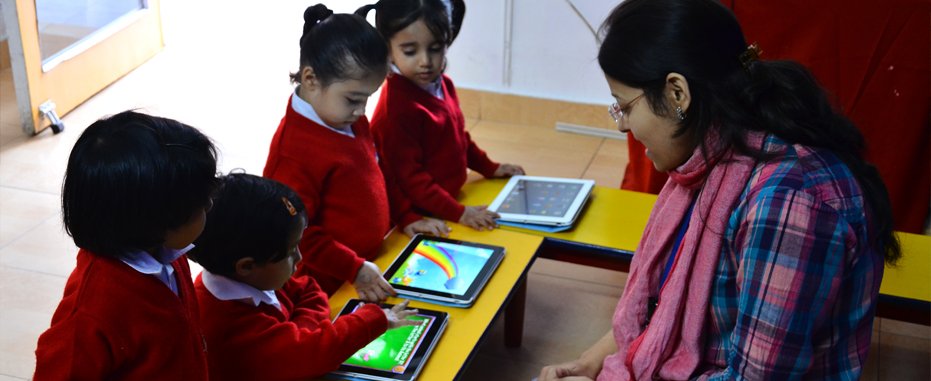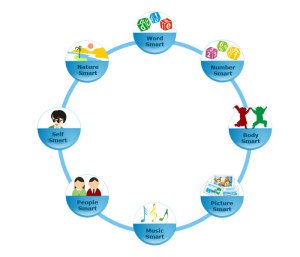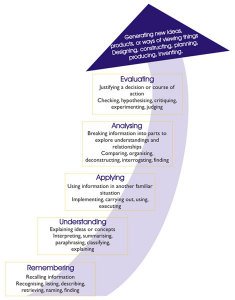
RESEARCH-BASED CURRICULUM
Every day, various branches of research throw up insights on child and adult learning. The unique thing about our curriculum is that the latest relevant research is synthesized into the curriculum and its various manifestations into the learning process. This helps make our curriculum highly engaging and relevant while following the guidelines of the respective boards. The highlights of our curriculum are encapsulated in the ‘what’ and the ‘how’.
‘What’ refers to the explicit and implicit content
- Explicit content is what people see, hear, and the books they read.
- Implicit content teaches students a variety of skills and helps them develop a level of awareness.
For example, in class when children are studying about world leaders, they not only learn history but also understand the qualities that are required in leaders. They are made to introspect and emulate the qualities of a leader.
‘How’ refers to the various methodologies used to engage all the senses of our students. We adopt within the curriculum varied research on evolving a high level of learning effectiveness. What you will find in this section are the three theories upon which we base these methodologies.
BASED ON BRAIN RESEARCH
Exciting discoveries in neuroscience and continued developments in cognitive psychology have presented new insights about the brain, the human neurological structure and the attendant perceptions and emotions that contribute to learning. Educators today are fascinated with the implications of connecting knowledge about how the brain works with teaching and learning in the classroom.
MULTIPLE INTELLIGENCE
Ask not “How smart is this student?”
but “How is this student smart?”
Dr. Howard Gardner’s Theory of Multiple Intelligence states that children develop preferred ways for learning. According to him, the traditional notion of a single IQ is severely limited. In the past, verbal, logic and math skills were equated with ‘intelligence’, while skills in areas such as art, music or social behavior were seen simply as ‘talents’. In contrast, Dr. Gardner says all areas should be equally valued and be called intelligences. Further, all intelligences are present in each of us, though in varying degrees. Thus, each individual has a unique intelligence profile, which he/she uses to make sense of the world.
INTEGRATED, THEME-BASED CURRICULUM
Using themes to organize instruction for young children has been popular since John Dewey, an American philosopher, psychologist, and educational reformer first proposed that curriculum should be related to real-life experiences.
Theme teaching helps children to form complex concepts from fragments of information. Not only does theme teaching enhance children’s concept development, it also provides a means for integrating content learning and processes learning in ways that are meaningful to them.
BLOOM’S TAXONOMY
Our curriculum is based on Bloom’s Taxonomy. This helps our students to master the higher order thinking skills, equipping them to convert their knowledge into solutions for real life problems.
Higher order thinking skills enable students to:
- Move beyond just knowing and understanding to applying knowledge
- Explore the reason behind things and its finer nuances.
- Evaluate from more than one perspective.
- Create new and exciting things based on their discoveries and evaluation.
The emphasis on utilizing higher order questions not only decides what is taught; it also influences how it is taught as well as assessed. For instance, teachers do not constantly test students with factual, literal, knowledge-based questions that require students to merely draw on short-term memory. Instead, they are taught to understand, think, apply, analyze, evaluate and create through questions of a higher order.
DEVELOPMENTALLY APPROPRIATE
Curriculum is considered age appropriate or developmentally appropriate if it is based on knowledge of how most students grow and what they can do socially, emotionally, cognitively and physically, at a given age.
At Kangaroo Kids and Billabong High International, classroom activities are planned in such a manner that they are appropriate to students’ developmental abilities and support each student’s physical, intellectual and emotional growth.
Although we look at each aspect of development separately, all areas of development are interrelated and therefore integrated within the curriculum.
Social Development – Addresses how the student relates to others.
Physical Development – Includes growth in size, strength, motor skills and coordination.
Cognitive Development – Refers to how the student thinks, processes information, solves problems and uses language to communicate.
Emotional Development – Relates to feelings about self and others.
SUPERIOR QUALITY STANDARD
To ensure Superior Quality Standards, the KKEL Operations Department has a School Improvement Team. This department is responsible on an ongoing basis to identify initiatives to continually improve the quality of KKEL’s methods, outcomes and people.
The 21st century has newer dimensions. Competition is cutthroat, information is on overload, technology is exciting and choices can be overwhelming.
The environment at work and home will be much more advanced, complex and stressful. Interpersonal interactions will also be of a very different level.
- Critical Thinking
- Collaboration
- Written and Oral Communication
- Creativity
- Self Direction
- Leadership
- Adaptability
- Responsibility
- Global awareness


